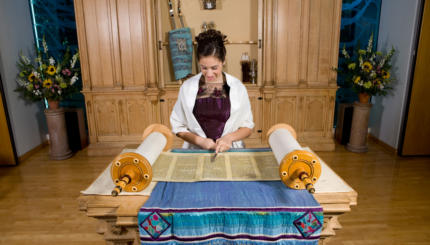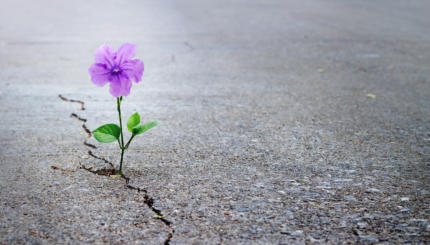The rabbinic duality of yetzer hara, the so-called “evil inclination,” and yetzer hatov, the “good inclination,” is more subtle than the names connote. Yetzer hara is not a demonic force that pushes a person to do evil, but rather a drive toward pleasure or property or security, which if left unlimited, can lead to evil (cf. Genesis Rabbah 9:7). When properly controlled by the yetzer hatov, the yetzer hara leads to many socially desirable results, including marriage, business, and community.
For the rabbis, adults are distinguished from children by the yetzer hatov, which controls and channels the drives that exist unchecked in the child. Thus children may seek pleasure and acquisition, but they are not able to create a sanctified relationship or exercise the responsibility to engage in business.
Developing a Moral Sense
The classical text that describes how children are born with a yetzer hara but only later develop a yetzer hatov comes from d’Rabbi Natan, a third-century midrashic companion volume to the more well known Ethics of the Fathers.
The yetzer hara is 13 years older than the yetzer hatov. While still in the mother’s womb, the yetzer hara begins to develop in a person. If he begins to violate the Sabbath, nothing stops him. If he commits murder, nothing stops him. If he goes off to another sin, nothing stops him.

Help us keep Jewish knowledge accessible to millions of people around the world.
Your donation to My Jewish Learning fuels endless journeys of Jewish discovery. With your help, My Jewish Learning can continue to provide nonstop opportunities for learning, connection and growth.
But 13 years later, the yetzer hatov is born. When he violates the Sabbath, it rebukes him, “Airhead [literally: “empty one”]! Don’t you know it says ‘Everyone who violates it will surely be put to death’ (Exodus 31:14)?” If he is about to commit murder, it rebukes him, “Airhead! Don’t you know it says ‘Whoever sheds a man’s blood, by man will his blood be shed’ (Genesis 9:6)?” If he is about to engage in a sexual sin, it rebukes him, “Airhead! Don’t you know it says ‘Both the adulterer and the adulteress will surely be put to death’ (Leviticus 20:10)?” (Avot d’Rabbi Natan 16).
The examples in this text are extreme, but serve to make the point that even laws punishable by death are not necessarily “self-evident” to children. The young adult is not described as someone who has developed a sophisticated moral sense; in fact, the early adolescent may base moral decisions entirely on fear of punishment. Yet by age 13, the child’s moral sense has developed sufficiently to hold the child responsible for his or her actions.
The distinction between the yetzer hara and the yetzer hatov is also derived by the midrash and later commentators from the verse, “Better a poor and wise child than an old and foolish king who no longer knows to receive admonition” (Ecclesiastes 4:13). The 11th-century commentator Rashi interprets this verse phrase by phrase:
Better a poor and wise child: This is the yetzer hatov, and why is it called a child? Because it does not enter a person until 13 years.
poor: because the limbs do not obey the yetzer hatov as they do the yetzer hara.
wise: which gives a person intelligence to follow the good way.
than an old and foolish king: the yetzer hara which rules over all the limbs.
old: for when the child is born, it is put into him, as it is said sin lies at the opening” (Genesis 4:7).
and foolish: for it misleads him in the way of evil…
who no longer knows to receive admonition: for the yetzer hara has become old and does not accept reproof (Rashi on Ecclesiastes 4:13).
Battling for Control of the Body
As Rashi points out, a significant battlefield for the two inclinations is control over the physical body of the adolescent. Rashi’s reference to control of the limbs may indicate the typical awkwardness that accompanies adolescent growth, but is more likely a euphemism for control over awakening sexual desire. Since the yetzer hara is older and stronger, few adolescents, in Rashi’s view, apparently maintain control over those desires. Rashi’s final comment concerning how the yetzer hara “does not accept reproof” describes the real difficulty of unlearning habits and attitudes acquired in childhood.
R. Isaac Arama, the 15th-century Spanish philosopher and commentator, connected the changes around to the well-known beginning of the Mishnaic tractate on Passover:
For the first 13 years of life, one rebels, but in the 14th year, the light of intelligence appears in him, and then he becomes bar mitzvah and subject to the punishment of a human court. Similarly, our sages, of blessed memory, hinted at this when they said, “On the evening of the 14th we search for [leaven] by the light of a candle” (Mishnah Pesachim 1:1) (Sefer Akedat Yitzhak, 61).
For Arama, the philosopher, the change that signals maturation is intellectual development, and the candle is a symbol of the adolescent’s greater ability to perceive the significant legal distinctions, which also makes him liable for punishment in court. The early 19th-century leader, R. Abraham Joshua Heschel of Apta, Poland, restated Arama’s insight in terms of the birth of the yetzer hatov:
On the night of the 14th we check for hametz with a candle, for in Nisan, renewal comes to the world. Israel becomes like a child whose yetzer hatov does not enter him until after 13 years. Similarly, we check for hametz after the 13th night by the light of a candle, on the model of a child who becomes bar mitzvah after 13 years. And then we must remove [literally destroy, l’va’er] all of the bad characteristics [of childhood] (Sefer Ohev Yisrael–Parashat Vayetze).
Bar/Bat Mitzvah and Passover
The association of bar mitzvah with Passover is a fruitful one. Just as Arama understands young adulthood as a time of increased “enlightenment” and the Apta Rebbe as the stage when the bad characteristics are destroyed, others see it as the period when the adolescent gains a certain degree of freedom. Freedom, however, should not be construed simply as freedom from parental control, but rather as freedom to take on more adult responsibilities. As the Israelites left Egypt to receive the , the bar or (partially) leaves parental authority in order to take on the responsibilities of Jewish adulthood.
R. Kalonymus Kalman Epstein of Cracow, a contemporary of R. Heschel of Apta and a fellow student of the great Hasidic rebbe Elimelekh of Lizhensk, also considered the psychological changes that occur in the early adolescent. R. Epstein, however, identifies the changes as part of a long process.
And it seems from the holy books, that initially, “man is born a wild ass” (Job 11:12), and he has no yetzer hatov, only yetzer hara, until he is 13 and becomes a bar mitzvah. Then the yetzer hatov comes upon him, and he begins with the of wearing [phylacteries]. This causes his heart to be awakened to the worship of God. This happens very, very slowly, but he is still full of self-centeredness and confused thoughts. Therefore the obligation is cast upon all who have a desire to connect to God to uproot evil thoughts from one’s heart and mind. Afterwards, as he continues to grow in his worship of God and matures, he is already well rooted in the worship of God. Nevertheless, it is the characteristic of the truly righteous and pious to continue to examine and explore one’s acts and find one’s own shortcomings… (Sefer Ma’or v’Shemesh, Parashat Lekh-L’kha).
Rashi pointed out how hard it is for the yetzer hatov to overcome the yetzer hara’s control over one’s sexual urges. R. Epstein extends this to the entirety of one’s spiritual being. The birth of the yetzer hatov does not make life easier; it makes life more difficult, at least for those who “desire to connect to God.” R. Epstein’s realistic description of the process of growth and self-examination as being lengthy provides a valuable lesson for the young adult. Bar and bat mitzvah are significant milestones, but they are not transformative. They mark the beginning of a process that takes place “very, very slowly.”
Each year we spend several weeks preparing for Passover, and then we relive the Exodus for a single week. After Passover, we spend six more weeks preparing for the acceptance of the Torah on the festival of Shavuot. Similarly, the young Jew may prepare a long time for the relatively short celebration of the bar or bat mitzvah. The real work, however, comes in the process of becoming the kind of responsible Jewish adult that the community of Israel esteems.



